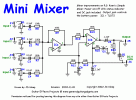Güncel olmayan bir tarayıcı kullanıyorsunuz. Bunu veya diğer web sitelerini doğru şekilde görüntülemeyebilir.
Yeni sürüme geçmeli veya bir alternatif kullanmalısınız. tarayıcı.
Yeni sürüme geçmeli veya bir alternatif kullanmalısınız. tarayıcı.
Mini Mixer
- Konuyu başlatan uydudoktoru
- Başlangıç Tarihi
Three Channel Audio Mixer Circuit
Description
Although the modular Portable Mixer design available on these web pages has become a hit for many amateurs, some correspondents required a much simpler device, mainly for mixing mono signals. This design should fulfil their needs, featuring three inputs with switchable high/low sensitivity and unusual level-control circuits, providing high overload margins and low-noise figures, proportional to gain-level settings. Low current consumption due to a simple, five-transistor circuitry, allows the Mini Mixer to be powered by a common 9V PP3 battery for many hours.
Circuit diagram:

Parts:
Description
Although the modular Portable Mixer design available on these web pages has become a hit for many amateurs, some correspondents required a much simpler device, mainly for mixing mono signals. This design should fulfil their needs, featuring three inputs with switchable high/low sensitivity and unusual level-control circuits, providing high overload margins and low-noise figures, proportional to gain-level settings. Low current consumption due to a simple, five-transistor circuitry, allows the Mini Mixer to be powered by a common 9V PP3 battery for many hours.
Circuit diagram:

Parts:
- P1 = 5K
- P2 = 5K
- P3 = 5K
- R1 = 180K
- R2 = 2M2
- R3 = 750R
- R4 = 1K
- R5 = 15K
- R6 = 220R
- R7 = 1.5K
- R8 = 820R
- R9 = 150R
- R10 = 100K
- R11 = 180K
- R12 = 2.2M
- R13 = 750R
- R14 = 1K
- R15 = 180K
- R16 = 2M2
- R17 = 750R
- R18 = 1K
- C1 = 1µF-63V
- C2 = 100µF-25V
- C3 = 220µF-25V
- C4 = 100µF-25V
- C5 = 220µF-25V
- C6 = 1µF-63V
- C7 = 100µF-25V
- C8 = 1µF-63V
- C9 = 100µF-25V
- Q1 = BC550C
- Q2 = BC547
- Q3 = BC557
- Q4 = BC550C
- Q5 = BC550C
- B1 = 9V PP3 Battery
- J1,J2,J3 = 3mm Mono Jack sockets
- SW1,2,3,4 = SPST Toggle or Slider Switches
- When SW1, SW2 or SW3 are open the input sensitivity is suited to high-output devices like CD players, tuners, tape recorders, iPods, miniDisc players, computer audio outputs etc.
- When SW1, SW2 or SW3 are closed the input sensitivity is suited to low-output, low-impedance moving coil or electret microphones.
- Sometimes, the 750 Ohm value for R3, R13 and R17 resistors could be not easy to find. In this case, two 1K5 resistors wired in parallel can be used to replace each item.
- To make a stereo mixer, all the parts must be doubled excepting R6, C3, C5, SW4 and B1.
Son düzenleyen: Moderatör:
No-Frills 6-Input Stereo Line Mixer
Updated 14th December 2010
(A companion article detailing a 6-output Line Distribution Amplifier can be found here:
I wanted a small (physically) mixer to accept line signals that was both simple and low-cost, for use as both an input expander for PC Soundcard input and also for general use in recording. Looking around the web reveals a whole host of designs, most of which are either over-blown, badly-designed or are just rubbish. My spec was simple and is as follows:
Updated 14th December 2010
(A companion article detailing a 6-output Line Distribution Amplifier can be found here:
I wanted a small (physically) mixer to accept line signals that was both simple and low-cost, for use as both an input expander for PC Soundcard input and also for general use in recording. Looking around the web reveals a whole host of designs, most of which are either over-blown, badly-designed or are just rubbish. My spec was simple and is as follows:
- Flat frequency response 40-40,000Hz
- Low Noise
- Will run off a single polarity supply as low as 9 volts
- Wide tolerance of input levels
- Nominal Input Impedance ~1KΩ
- Low cost
Eklentiler
Son düzenleyen: Moderatör:

